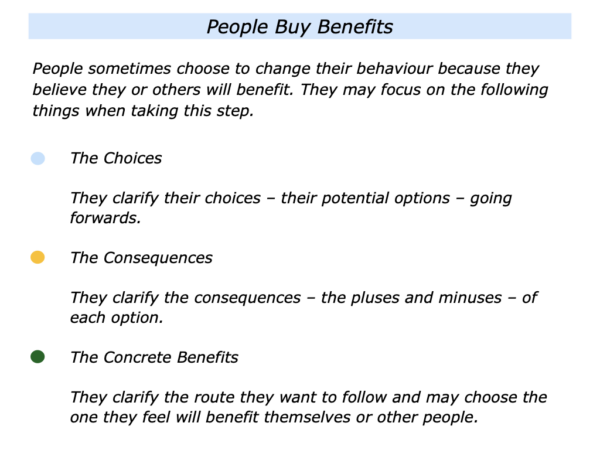
There are many views about what motivates people to change their behaviour. One view is that people choose to take a different approach when they feel that they or other people will benefit.
There are many examples of this approach. A person may choose to change their behaviour when, for example:
They will get more pleasure or less pain;
They will get more benefits for themselves or other people;
They will be more likely to achieve their picture of success.
Different people choose to change their behaviour for different reasons. One of the main factors, however, is that they want to get the benefits. Let’s look at some examples.
A person may experience a health warning and then choose to develop a healthier lifestyle. They may do so because they want to feel better, live longer and see their children grow up.
A parent may realise that focusing on negative things in life is not helping them or their loved ones. They may therefore choose to develop a sense of gratitude, focus on positive things in life and encourage other people.
A founder of a business may realise that micromanaging may not scale the business. They may then choose to learn how to manage by outcomes – rather than by tasks – and find ways to get the best from their staff.
Imagine that your work involves helping people to develop and, in some cases, changing their behaviour. There are several guidelines it can be worth bearing in mind. Let’s explore these themes.
People Like To Feel In
Charge Of The Change
People like to feel in control. They like to feel in charge of the change rather than that others are trying to change them. People need to have the will before they can learn the skill.
Different people reach this point in different ways. These include the following reasons.
They may realise that behaving in a certain way is not getting the desired results. They may keep doing the same things and hope it works. They may then reach a point where they want to try something different.
They may have a Eureka moment that leads to wanting to change their behaviour. They may experience an illness, a setback or another life-changing event. This encourages them to explore another way.
They may see a better way of achieving their aims. They may take this step by themselves through reading or learning from a positive model. They may on occasions be helped to do this by another person.
Looking at my own work as a mentor, for example, I normally only work with people who want to develop. There have been times, however, when people have been referred to me.
This can be more challenging. The aim is to create a positive environment in which the person feels at ease. It is to then give them the following messages.
Welcome to the session. I know that you have many strengths and want to achieve your personal or professional goals. I also know that sometimes you meet challenges along the road.
Bearing this in mind, it is up to you if you would like to explore the possible ways forwards. When doing so, the aims will be:
To start by clarifying the goals you want to achieve in your life or work – your picture of success;
To build on your strengths – the things that are working – and, if you wish, to offer some practical tools you can use to tackle any challenges;
To channel your personality rather than change your personality and also add to your repertoire to achieve your picture of success.
Let me know if you are interested. If so, we can focus on how you can build on your successful patterns – plus maybe add other skills – to get positive results and achieve success.
Some people spend a lot of time trying to convince others that they should change. They may try to persuade another person or try to find some trigger that will get the person to alter their behaviour.
This approach can come across as criticism and be counterproductive. The person on the receiving end can feel attacked and may respond badly to such messages.
There is another approach that can be effective when helping a person to change their behaviour. People must see there are benefits. They are then more likely to want to explore the possible options going forwards.
Sometimes they see these benefits themselves. Sometimes it is possible to paint a picture that shows the benefits for them, for other people, for their organisation or for the planet.
Let’s assume that a person has begun to see the benefits of maybe behaving in another way. This can then lead to the next stage.
People Can Choose To Change Their
Behaviour By Focusing On The Choices,
Consequences And Concrete Benefits
Imagine that a person has asked for your help in exploring their possible ways forward. Different individuals may have different reasons for seeking help. These may include some of the following:
They may be encountering a problem and want to find ways to tackle the challenge;
They may want to change aspects of their personal or professional life and achieve positive results;
They may want to follow strategies that will help them to achieve their picture of success.
You will begin by making the person feel welcome. The next step will be to clarify the theme they want explore. It will be important:
To clarify what is happening at the moment and the results they want to achieve in the future – their picture of success;
To clarify their possible choices going forwards and the consequences – the pluses and minuses of each option – and potential creative solutions;
To clarify their chosen way forward – together with the benefits – and the strategies that will give them the greatest chance of success.
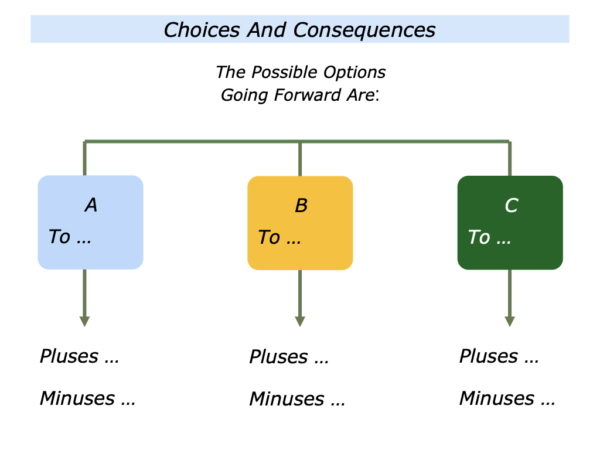
As mentioned above, sometimes it can be important to clarify what is happening at the moment and the results the person wants to achieve in the future. But sometimes the person may not have yet have an idea of the results they want to achieve.
If that is the case, you may simply want to move on to exploring their possible ways forwards. You can also invite them to consider what may be the pluses and minuses of each option.
If appropriate, and only after you have asked their permission, you can share what you see as any other possible ways forwards. This can include any potential creative solutions.
Imagine that the person has explored the potential options going forwards. If appropriate, you may then say something along the following lines.
Looking ahead, what is the option you find most attractive? What may be the pluses – the concrete benefits – of taking this route? We can also look at how to manage any potential minuses.
On a scale 0-10, how motivated do you feel to follow this route? If appropriate, we can explore how to maintain or improve this rating. We can also focus on the strategies most likely to achieve success.
Let’s assume the person has chosen the route they want to follow. They can then focus on how to translate this into action. This can involve exploring their next step in helping people to change their behaviour.
People Can Build On Their Previous
Successful Patterns To Change Their
Present Behaviour And Get The Benefits
People often like to develop and are sometimes wary of trying to change. This highlights several key points in helping people to change their behaviour.
Sometimes it can be useful to follow the organic approach to help people to develop. This approach is based on the following themes.
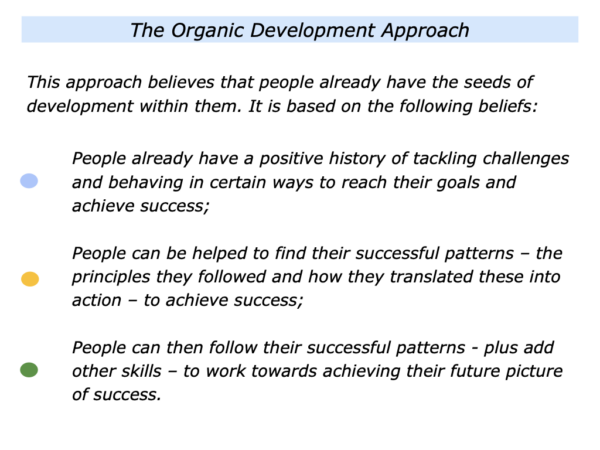
Let’s explore how it is possible to take this approach. Imagine that the person aims to follow a particular route and behave in a certain way to work towards their goals.
Bearing in mind the actions they want to take, it can be useful to explore their positive history. This involve taking the following steps:
To clarify their successful pattern by recalling a situation when they behaved in this way successfully – even if only for a short time;
To clarify what they did right then – the principles they followed and how they translated these into action – to behave successfully;
To clarify how they can follow these principles – plus maybe add other skills – and behave in a way that is likely to increase the chances of success.
A person is more likely to believe in following a certain path if they are building on existing successful habits. They have succeeded in the past and can succeed again in the future. The key is:
To focus on how they can pursue these principles – plus maybe add other skills – to give themselves the greatest chance of success.
The organic approach is one that I have seen work many times. It is vital to apply it in a realistic way, however, and translate it into a clear action plan. Later we will explore how to take that step. Before then, however:
There Is Another Option
There may be times when it may be necessary for a person to add a totally new habit. It is possible to help them to do this but they need: a) to see the benefit; b) to rehearse following the habit in difficult situations.
Imagine that the person has chosen to follow a certain route and has translated this into a clear action plan. They may aim, for example, to do one or more of the following things:
To stay sober … To follow a healthy lifestyle … To encourage people … To stay calm rather than get angry … To be a positive leader … To be better at managing key stakeholders … To behave in another way that improves the chances of achieving their picture of success.
Sometimes it can be useful to go beyond talking about what they want to do. They can be helped to rehearse following their chosen strategy in a particular situation.
Different people rehearse things in different ways. Some take the following approach.
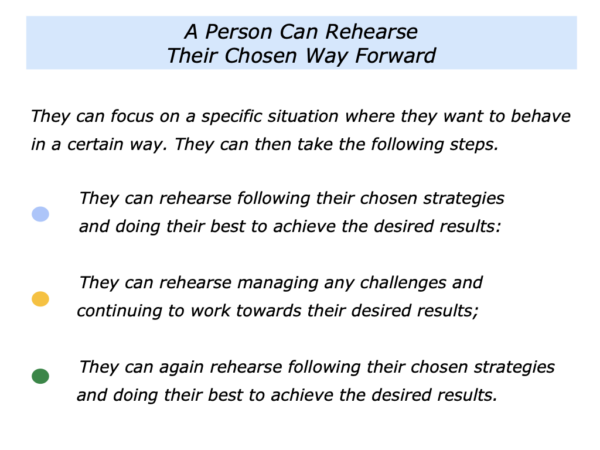
This is an approach that many people find helpful. They find it useful: a) to rehearse following their chosen strategies; b) to rehearse learning how to manage trigger situations that could send them into a negative spiral.
Imagine that a person has gone through some of the steps we have explored and has settled on their action plan. The keys are for them:
To believe in the strategy they want to follow towards achieving their picture of success;
To follow their strategy, build in some early successes and encourage themselves on the journey;
To find solutions to challenges and do their best to achieve their picture of success.
As mentioned earlier, people are more likely to change their behaviour when they see the benefits. If appropriate, you can use the ideas described in this piece to help a person to achieve their goals.
Different people will, of course, make their action plans in different ways. One approach is for them to use the following framework. They can adapt this in their own way and work towards achieving their picture of success.
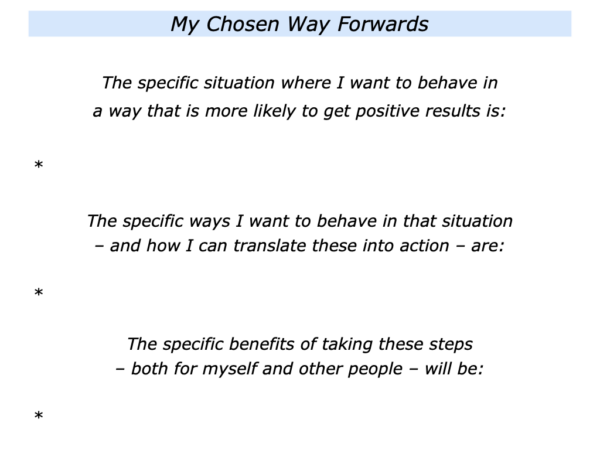






Leave a Reply